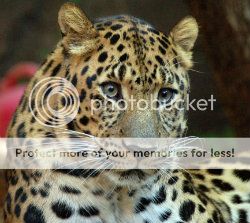Endangered Amur Leopard Faces Extinction

The Amur leopard (Panthera pardus orientalis), also known as the Far East leopard and the Manchurian leopard, is found in the snowy temperate forest of Primorsky Krai, located in eastern Russia. It is the rarest subspecies of Panthera in existence, and it is hanging on by a fine, frayed thread. A census count, using camera monitors, determined that there are fewer than 40 remaining in the wild.
The Amur leopards once roamed throughout Korea, China, and expansive parts of Russia. However, human expansion, the greed of poachers, and oil pipelines, took its toll on the animal's ability to survive. The continuation of human error is seen as these precious few survivors are captured and caged in zoos, under the guise of species preservation. However, this tactic further degrades the species due to unnatural and prolific inbreeding. This produces inferior offspring that have increased medical complications with a shorter life expectancy. The result is a watered-down version of the Amur leopard that is unlikely to survive in the wild, even if it were able to overcome the shortfalls of being born into captivity and then being set free. Hence, not preserving the species, but expediting their extinction.
Amur's run in excess of 35 miles per hour (56km/h), are able to vertically leap 19 feet (5.8m) and horizontally jump 10 feet (3m). On average, they are 5 feet (152cm) long, weigh about 100 pounds (45kg), and are adaptable to snowy climates because they have the longest legs in the Panthera genus. Their average lifespan in the wild is 15 years and they are territorial. Females keep a range of 35 square miles (90 square meters), and males traditionally keep a broader range of 155 square miles (401 square meters).
Under normal conditions, Amur leopards and tigers would traditionally overlap in living space. However, leopards keep more to trees and mountain ranges, which allows these two big cats to coexist peacefully with each other and share in nature's bounty. Both big cats are ecologically significant for maintaining a proper natural balance to other animal populations that are prolific breeders, like deer, rabbits, badgers, and rodents. They are better suited to this task than humans are, for these cats know better than to cull their prey out of existence; a lesson humankind has not yet mastered.
The urgent demand for their preservation has inspired conservation efforts to establish poaching patrols. Global Giving has set up a comprehensive online involvement campaign where people can volunteer or donate in an effort to protect the Amur leopard and capture poachers.
The Amur leopards once roamed throughout Korea, China, and expansive parts of Russia. However, human expansion, the greed of poachers, and oil pipelines, took its toll on the animal's ability to survive. The continuation of human error is seen as these precious few survivors are captured and caged in zoos, under the guise of species preservation. However, this tactic further degrades the species due to unnatural and prolific inbreeding. This produces inferior offspring that have increased medical complications with a shorter life expectancy. The result is a watered-down version of the Amur leopard that is unlikely to survive in the wild, even if it were able to overcome the shortfalls of being born into captivity and then being set free. Hence, not preserving the species, but expediting their extinction.
Amur's run in excess of 35 miles per hour (56km/h), are able to vertically leap 19 feet (5.8m) and horizontally jump 10 feet (3m). On average, they are 5 feet (152cm) long, weigh about 100 pounds (45kg), and are adaptable to snowy climates because they have the longest legs in the Panthera genus. Their average lifespan in the wild is 15 years and they are territorial. Females keep a range of 35 square miles (90 square meters), and males traditionally keep a broader range of 155 square miles (401 square meters).
Under normal conditions, Amur leopards and tigers would traditionally overlap in living space. However, leopards keep more to trees and mountain ranges, which allows these two big cats to coexist peacefully with each other and share in nature's bounty. Both big cats are ecologically significant for maintaining a proper natural balance to other animal populations that are prolific breeders, like deer, rabbits, badgers, and rodents. They are better suited to this task than humans are, for these cats know better than to cull their prey out of existence; a lesson humankind has not yet mastered.
The urgent demand for their preservation has inspired conservation efforts to establish poaching patrols. Global Giving has set up a comprehensive online involvement campaign where people can volunteer or donate in an effort to protect the Amur leopard and capture poachers.
You Should Also Read:
Jaguars Awarded Critical Habitat
The Dangers of Crossbreeding Big Cats
Support Wildlife Legislation

Related Articles
Editor's Picks Articles
Top Ten Articles
Previous Features
Site Map
Follow @WildlifeWelfare
Tweet
Content copyright © 2023 by Deb Duxbury. All rights reserved.
This content was written by Deb Duxbury. If you wish to use this content in any manner, you need written permission. Contact Deb Duxbury for details.







